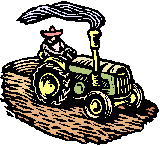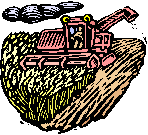


 |
Agricultural Education for Elementary Students |
 |
| Questions | |
|
|
| Websites | |
| www.agclassroom.org | United States Department of Agriculture: Agriculture in the Classroom. Includes a history of the program, resources for teachers including curriculum guides and resources, and an interactive "Kids' Zone." |
| www.iowafarmertoday.com | Iowa Farmer Today. Agricultural news and analysis, archives of past articles, a Corn Cam with photos of corn fields from around the world, and other information. |
| www.agday.org | AgDay.org. March 20th marks the first day of spring and National Agriculture Day. This website includes resources, links for students, and information to assist teachers in celebrating Ag Day in their classrooms. |
| pubs.aged.tamu.edu/jae | Journal of Agricultural Education. Allows you to search past issues of the journal for topics of your interest. |
| www.extension.iastate.edu/ | Iowa State Extension. Information on Iowa State Extension, and its support of agriculture, and 4H youth programs. Allows search within the site to find topics on agricultural education and safety programs. |
| www.kidsolr.com/science/page2a.html | KidsOLR (Kids Online Resources). Website for children with links to many other sites on agriculture-related topics. |
| On-line Articles | |
Record 1 Studying Food Technology? By: Berrett, Jared. Technology & Children, Dec2003, Vol. 8 Issue 2, p10, 1p; Abstract: This article focuses on studying food technology with the help of the internet as a resource to help in the creation of a sample lesson plan. One can look at how the body uses food, learn about the nutritional foods pyramid, research food production and preservation processes, or identify various careers in the food industry. Agriculture in the Classroom, provided by the U.S. Department of Agriculture (USDA), is an excellent no-cost resource to help create lesson plans on food and agricultural systems. ; ( AN 11721187 ) Persistent link to this record: proxy.lib.uiowa.edu/login?url=search.epnet.com/direct.asp?>an=11721187&db=afh |
|
Record 2 Feeding the hungry. Economist , 5/8/2004, Vol. 371 Issue 8374, p74, 1p, 1c; Abstract: The author discusses a new study on how to alleviate world hunger. Televised images of starving children with distended bellies have brought the problem of global hunger home to people in rich countries. Sadly, however, the problem is far deeper than an immediate lack of food, as a new paper for the Copenhagen Consensus project points out. Jere Behrman of the University of Pennsylvania, Harold Alderman of the World Bank and John Hoddinott of the International Food Policy Research Institute have examined the extent of hunger and malnutrition and four concrete proposals to ameliorate it. Around a billion people, say the authors, are malnourished, and around a sixth of these are children. That is not only a deplorable human tragedy in its own right. It also leads to measurable economic losses-ie, further poverty. But what can be done to address hunger directly? The first course they examine is halting the ill effects of hunger at the earliest possible stage: in utero. Next, the authors investigate improving nutrition in young children. Third is a reduction of deficiencies in key "micronutrients", such as iodine, zinc, vitamin A and iron. The fourth course is to improve agricultural technology-for example, by using higher-yielding crops (which are often genetically modified) and controlling pests better. The authors see investments in technology as the most effective means of increasing the incomes of hungry people. ; (AN 13065108 ) Persistent link to this record: proxy.lib.uiowa.edu/login?url=search.epnet.com/direct.asp?an=13065108&db=afh |
|